Help Prevent Lake Infestation
New Hampshire is currently battling five species of Exotic Aquatic Plants in its lakes and waterways. Over sixty water bodies are now impacted by exotic aquatic plants, including Squam and Winnipesauke lakes. Once introduced, they can render an area unsuitable for fish by exhausting dissolved oxygen, by blocking sunlight essential to basic food production. Excessive growth also interferes with swimming and boating. Once established, they are virtually impossible to eradicate and can decrease the economic value of waterfront property.
Click here to download a complete list of prohibited exotic aquatic plants.
Click here for details on what to do if you suspect an infestation.
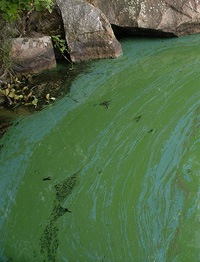 Cyanobacteria CyanobacteriaCyanobacteria, also known as blue-green algae, is a phylum of bacteria that obtain their energy through photosynthesis. Cyanobacteria reproduce explosively under certain conditions. This results in algal blooms, which can become harmful to other species if the cyanobacteria involved produce toxins. These toxins can be neurotoxins, hepatotoxins, cytotoxins, and endotoxins, and can be toxic and dangerous to humans as well as other animals and marine life in general.Click here to see the current DES page on cyanobacteria Click here to download a presentation from DES on Cyanobacteria |
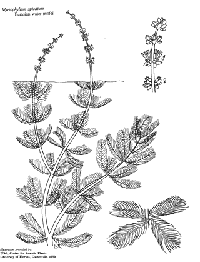 Eurasian Watermilfoil (Myriophyllum spicatum) Eurasian Watermilfoil (Myriophyllum spicatum)Eurasian watermilfoil is a submersed perennial plant. The stems are reddish to brown. The leaves are olive green, occur in whorls of three to six and have ten to 16 very narrow, dissected segments on each side that give them the appearance of weather-beaten feathers. Flowers occur on immersed spikes and usually in whorls of four.Click here to download a DES Factsheet on Eurasian Watermilfoil |
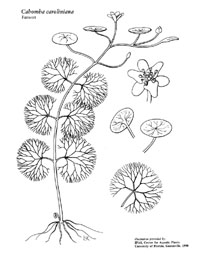 Fanwort (Cabomba caroliniana) Fanwort is a submersed plant. The leaves are opposite and divided into several or many narrow, Y-branching segments. Distinctive, diamond shaped floating leaves sometimes occur. Flowers are attached at the base of the floating leaves. The flowers are white to pink or purplish and about ½“ long.Click here to download a DES Factsheet on Fanwort |
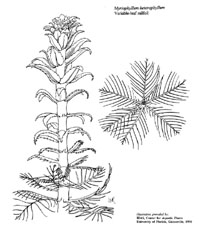 Variable Milfoil (Myriophyllum heterophyllum) Variable milfoil is a submersed perennial plant but often has immersed stems that rise up to six inches above the water surface. The leaves occur in whorls of four to six but are of two different types. The submersed leaves are limp, feather-like in appearance, 1” – 2½” long, 1” – 1½” wide and have eight to 18 very narrow, paired segments. The immersed leaves are stiff, not segmented, ½” – 1” long and 1/10” – ¼” wide. The flowers are inconspicuous and occur in whorls of four to six.Click here to download a DES Factsheet on Variable Milfoil |
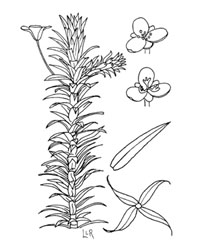 Brazilian Elodea (Egeria densa) Brazilian elodea is a submersed plant that is superficially very similar in appearance to Hydrilla. The leaves occur in whorls of, usually, four to eight and have minute teeth on the margin. Very dense layers of overlapping leaves at the stem tips are useful in separating this plant from hydrilla. The midveins are smooth. Only male flowers have been observed. These are white and greenish, up to 1” across and usually extend above the water surface. |
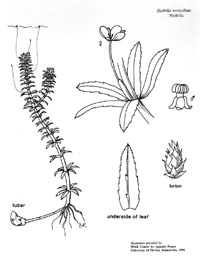 Hydrilla (Hydrilla verticillata) Hydrilla is a submersed plant that has very long internodes (stem sections between leaves) in deep water and shorter internodes and extensive branching near the water surface that causes dense mats. The leaves occur in whorls of, usually, four to eight. The leaves are strap shaped, with visible, curved, coarse teeth on the margin. The midvein is often red and often has at least one spine or bump on the lower surface. The teeth on the leaves usually make the plant rough to touch.Two different forms of hydrilla occur in the United States. One produces only female flowers (monoecious). The other produces both male and female flowers (dioecious). Female flowers are white, less than 1/3” across, attached to the plant and float on the water surface. Male flowers have three whitish-red or brown sepals that may be slightly larger than 1/10” long and less than 1/10” wide. They have three whitish or reddish petals that are less than 1/10” long and three stamens. |
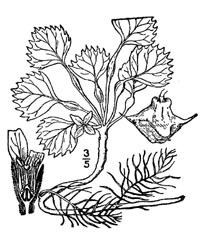 Water Chestnut (Trapa natans) Water chestnut has broad, toothed, diamond-shaped upper leaves which form tight floating rosettes. The leaves connect to the stem by swollen stalks just below the leaf blades. The thin limp stems give rise to long, narrow or feather-shaped underwater leaves and are rooted in the sediment. The fruit is a hard, woody nut with two to four sharp spines.Click here to download a DES Factsheet on Water Chestnuts |
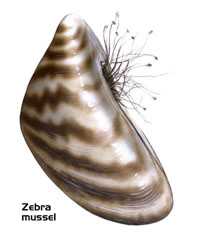 Zebra mussels (Dreissena polymorpha) Zebra mussels are small, freshwater mollusks from Eastern Europe, first discovered in North American in 1988. They have steadily invaded America’s rivers and lakes where they clog water intake pipes, damage boat engines and alter native species populations. Zebra mussels get their name from the striped pattern of their shells, though not all shells bear this pattern. They’re usually about fingernail size but can grow to a maximum length of nearly 2 inches. Zebra mussels live four to five years and inhabit fresh water at depths of six to 24 feet. A female zebra mussel begins to reproduce at two years of age, and produces between 30,000 and 1 million eggs per year.Click here to download a DES Factsheet on Zebra Mussels |